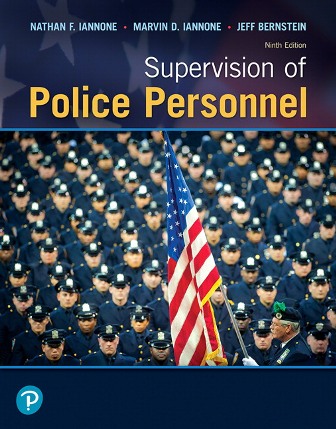This is completed downloadable of Test Bank for Supervision of Police Personnel, 9th Edition, Nathan F. Iannone, Marvin D. Iannone, Jeff Bernstein

Product Details:
- ISBN-10 : 0135186234
- ISBN-13 : 978-0135186237
- Author: Nathan F. Iannone, Marvin D. Iannone, Jeff Bernstein
Longtime best-selling Supervision of Police Personnel addresses the essential knowledge, skills, and characteristics every professional law enforcement supervisor and manager should have. This authority in the field examines what it takes to move from officer to supervisor; key supervisory responsibilities such as training, coaching, and counseling; and dealing with citizen complaints, problem employees, and tactical deployment of field forces in critical situations. The 9th edition features extensive revisions, including two new chapters: “Legal Knowledge Every Supervisor and Manager Should Have” (Chapter 14) and “Other Important Supervisory and Management Topics” (Chapter 15).
Table of Content:
- 1 The Supervisor’s Role
- Chapter Objectives
- Supervisory Position
- Technical and Supervisory Competence
- Organizational Knowledge
- Basic Supervisory Responsibilities
- Planner
- Personnel Officer
- Trainer
- Coach
- Counselor
- Controller
- Decision Maker and Communicator
- Leader
- Transition from Officer to Supervisor
- Summary
- Review Questions
- Exercises
- Endnotes
- 2 The Supervisor’s Function in Organization, Administration, and Management
- Chapter Objectives
- Administrative Functions
- Planning
- Organizing
- Staffing
- Directing
- Coordinating
- Basic Organizational Structures
- Line Organization
- Functional Organization
- Line and Staff Organization
- Division of Work
- Unity of Command
- Span of Control
- Delegation
- Delegation Failures
- Delegation Process
- Personnel Development by Delegation
- The Exception Principle
- Delegation of Staff Projects
- Researching Projects
- Planning Projects
- Summary
- Review Questions
- Exercises
- Endnotes
- 3 Leadership, Supervision, and Command Presence
- Chapter Objectives
- Development of Leadership Ability
- Types of Leaders
- Autocratic Leader
- Democratic or Participatory Leader
- Free Rein or Laissez-Faire Leader
- Situational Leadership
- Transformational Leadership and Empowerment
- Selection of a Leadership Style
- Command Presence and Leadership
- Elements of Leadership
- Discipline
- Ethics
- Common Sense
- Psychology
- Motivation of Employees
- Situational Analysis and Self-Appraisal
- Leadership Characteristics
- Personality of a Leader
- Human Relations and Leadership
- Manner of the Leader
- Language of the Leader
- Commendations and Praise by the Leader
- Criticism and Reprimands by the Leader
- Knowledge of Subordinates
- Supervision of the Marginal Employee
- Order Giving
- Direct Commands
- Requests
- Implied or Suggested Orders
- Requests for Volunteers
- Method of Communication
- Follow-Up
- Decision-Making
- Drawing of Conclusions
- Moderation in Supervision
- Fraternization
- Example Setting
- Female Supervisors
- Supervising a Diverse Workforce
- Supervising the Multigenerational Workforce
- Avoidance of Gender Bias and Harassment
- Symptoms of Leadership Failure
- Leadership Issues in Community Policing
- Magnifying Community Policing through Social Media
- Summary
- Review Questions
- Exercises
- Endnotes
- 4 The Training Function Problems and Approaches to the Instructional Process
- Chapter Objectives
- Importance of Training
- Causes and Effects of Training Failure
- Remedy for Failure
- Instructor’s Approach to Teaching
- Instruction as a Supervisory Responsibility
- Need for Training
- Principles of Learning
- Principle of Readiness
- Principle of Effect
- Principle of Repetition
- Principle of Primacy
- Principle of Recency
- Principle of Intensity
- Learning Process Variables
- Learning Rate
- Andragogy
- Adult Learner Differences
- Motivation
- Interest and Learning Effectiveness
- Learning Patterns
- Instructional Goals and Specific Objectives
- Analysis of Job Tasks and Material Selection
- Lesson Plan
- Form
- Teaching Sequence
- Learning by Association
- Five Steps of Teaching
- Introduction
- Presentation
- Review
- Application
- Test
- General Problems Affecting Teaching Method
- Common Causes of Teacher Ineffectiveness
- Teaching Methods
- Lectures
- Roll Call Training
- Guest Speakers
- Online Training
- Role Playing and Field Problems
- Stress Management Simulations
- Virtual Training Simulators
- Workshops
- Demonstrations
- Group Discussions
- Panel Discussions
- Conferences
- Staff Meetings
- Planning
- Follow-Up
- Use and Misuse of Procedures
- Use of Questions
- Use of Teaching Aids
- Types of Teaching Aids
- Display Aids
- Duplicated Aids
- Projected Aids
- Three-Dimensional Aids
- Electronic Media Devices
- Field Trips
- Additional Training Resources
- Summary
- Review Questions
- Exercises
- Endnotes
- 5 Interpersonal Communications
- Chapter Objectives
- Cultural, Environmental, and Psychological Factors
- Processes of Communications
- Barriers to Effective Communications
- Failure to Listen
- Status Differences
- Psychological Size
- Noise
- Language Barriers
- Fear of Criticism
- Jumping to Conclusions
- Filtering
- Individual Sentiments and Attitudes
- Intentional Suppression or Manipulation of Communications
- Complexity of Communications Channels
- Overloading of Communications Channels
- Overstructuring of Communications Channels
- Overcoming Communication Barriers
- Determine Objectives
- Practice Empathy
- Obtain Feedback
- Keep Subordinates Informed
- Be Consistent in Communicating
- Make Actions Speak Louder than Words
- Listen, Understand, and Be Understood
- Characteristics of Communications
- Autocratic Communications
- Democratic Communications
- Free Rein Communications
- Types of Communicators
- Written Communications
- Clarity of Expression
- Simplicity
- Accuracy
- Arrangement
- Style
- Summary, Conclusions, Recommendations, and Plan of Action
- Format
- Effectively Managing Your Email
- The Four Ds for Decision-Making Model
- Decide what to do with each and every message
- Do it (if it takes less than two minutes)
- Delegate it
- Defer it
- Use the 4 Ds model every day
- Manuals—Orders
- Briefing
- Proofreading and Editing
- Typical Deficiencies in Writing
- Summary
- Review Questions
- Exercises
- Endnotes
- 6 Principles of Employee Interviewing
- Chapter Objectives
- Interrogation versus Interview
- Major Functions of the Interview
- Preparation for an Employee Interview
- Preliminary Planning
- Privacy
- Types of Questions
- Conducting an Interview
- Interview Opening
- Use of Questions
- Interviewer Attitude
- Employee-Centered Approach
- Active Listening
- Elimination of Bias
- Confidential Agreements
- Advice Giving
- Psychological Reactions in the Interview
- Types of Personnel Interviews
- Informal Interview
- Employment Interview
- Progress Interview
- Grievance Interview
- Problem-Solving Interview
- Disciplinary Action Interview
- Separation Interview
- Recording of Results
- Evaluation of Results
- Causes of Unsuccessful Interviews
- Summary
- Review Questions
- Exercises
- Case 1: The Transfer Interview
- Case 2: The Grievance Interview
- Case 3: The Problem-Solving Interview
- Endnotes
- 7 Some Psychological Aspects of Supervision
- Chapter Objectives
- Drives, Satisfactions, and Needs
- Drives
- Satisfactions
- Needs
- Inferiority Complex
- Catharsis
- Fixation and Regressive Behavior
- Supervisory Problem: The Frustrated Employee
- Nature of Frustration
- Barriers Causing Frustration
- External Barriers
- Internal Barriers
- Frustration and Performance
- Some Common Reactions to Frustration
- Aggression
- Attitude of Resignation
- Escape
- Excuses and Rationalizations
- Regression
- Fixations
- Frustration Prevention
- Relief for Frustration: Some Commonsense Approaches
- Summary
- Review Questions
- Exercises
- Endnotes
- 8 Special Problems in Counseling and Remediation
- Chapter Objectives
- Nature of Problem Drinking
- Development and Symptoms of Problem Drinking
- Development of the Problem
- Symptoms of the Problem
- Some Options in Treating the Problem Drinker
- Off-the-Job Problem Drinking
- Indirect Solicitation for Help
- Job-Related Problem Drinking
- Drinking and Deteriorating Job Performance
- Counseling for the Problem Drinker
- Preliminary Action
- Counseling Sessions
- Note Taking
- Referral
- Objective of Professional Counseling
- Emotional and Personal Problems
- Psychological Symptoms
- Physiological Symptoms
- Supervisory Role
- Counseling for the Emotionally Troubled Subordinate
- Management and Remediation of Emotional Distress
- Occupational Stress
- Depression
- Suicide Awareness and Prevention
- Family Discord
- Trauma-Producing Incidents
- Summary
- Review Questions
- Exercises
- Endnotes
- 9 Employee Dissatisfaction and Grievances
- Chapter Objectives
- Dissatisfaction with Work Environment
- Inept Supervisory Practices
- Misunderstandings of Policies, Rules, and Procedures
- Management Failures
- Rules of Conduct
- Rule Enforcement
- Due Process Violations
- Supervisory Influence on Non–Job-Related Employee Behavior
- Recognition of Employee Dissatisfaction
- Supervisory Approaches to Employee Dissatisfaction
- Employee Grievances
- Noncontractual Matters
- Contractual Violations and Grievances
- Working with Unions
- Summary
- Review Questions
- Exercises
- Endnotes
- 10 Discipline Principles, Policies, and Practices
- Chapter Objectives
- Forms of Discipline
- Positive Discipline
- Negative Discipline
- Adverse Effects of Punishment
- Detection of Problem Employee Behavior
- Requisites of Punishment
- Certainty
- Swiftness
- Fairness and Impartiality
- Consistency
- Deterrence for Others
- Discipline by Example
- Upward Discipline
- Interdependency of Discipline, Morale, and Esprit de Corps
- Reversals of Administrative Actions
- Results of Unsustained Disciplinary Actions
- Complaint Investigation Policy
- Procedure
- Objectives
- Vicarious Liability
- Coroner’s Transcripts
- Summary
- Review Questions
- Exercises
- Endnotes
- 11 Personnel Complaint Investigation Procedures and Techniques
- Chapter Objectives
- Case Preparation
- Sources of Complaints
- Internal Complaints
- External Complaints
- Anonymous Complaints
- Non–Job-Related Misconduct
- Observed Infractions
- Discuss in Private
- Record Results
- Follow Up
- Complaint Types
- Primary Complaints
- Anonymous Complaints
- Complaints from Intoxicated Persons
- Second-Party Complaints
- Recording of Complaints
- Complaint Investigation
- Avoidance of Premature Conclusions
- Prevention of Additional Harm
- Arrest and Booking of Employees
- Promptness of Investigation
- Collection of Negative Information
- Personnel Record Check
- Interview of the Accused Employee
- Legal Counsel
- Written Statements
- Avoidance of Face-to-Face Encounters
- Searches
- Lineups
- Investigative Aids
- Physical Tests
- Procedural Due Process Requirements
- Charges and Specifications
- Balancing Test
- Protective Rules for Employees
- Reporting Procedures
- Investigative Report
- Pagination and Cross-References
- Avoidance of Offensive Terminology
- Classification of Complaint Investigations
- Discipline and the News Media
- Disposition of Complaints
- Notification to the Complainant
- Notification to the Accused Employee
- Imposition of a Penalty
- Disciplinary Failures
- Summary
- Review Questions
- Exercises
- Endnotes
- 12 Personnel Evaluation Systems and Performance Rating Standards
- Chapter Objectives
- Objectives of Evaluation Systems
- A Case for Evaluation Systems
- Causes of Evaluation System Failures
- Indifference
- Employee Pressures
- Failure to Train Raters
- Rating Abuses
- Slipshod Procedures
- Rating Shortcuts
- Gathering and Recording of Performance Data
- Recording Methods
- Critical Incident Technique
- Rating Traits
- Performance Standards
- Rating Criteria
- Patrol and Traffic Personnel
- Investigative Personnel
- Staff and Auxiliary Personnel
- Rating Standards
- Employee Ranking
- Representative Employee Standard
- Ideal Employee Standard
- Numerical Standard
- Forced-Choice Standard
- Rater Characteristics
- Common Rating Errors
- Leniency
- Personal Bias
- Central Tendency
- Halo or Horns Effect
- Related Traits
- Overweighting or Recency
- Subjectivity
- Validity and Reliability of Ratings
- Validity
- Reliability
- Evaluation Period
- Rating Methods
- Composite Ratings
- Group Ratings
- Individual Trait Ratings
- Discussion of Rating with Employee
- Interview
- Acknowledgment of Rating
- Follow-Up
- Written Notification of Rating
- Summary
- Review Questions
- Exercises
- Endnotes
- 13 Tactical Deployment of Field Forces
- Chapter Objectives
- Supervisory Responsibilities in Unusual Occurrences
- Basic Procedures for Unusual Occurrences
- Communication of Field Intelligence
- Establishment of a Command Post
- Incident Command System (ICS)
- Reconnaissance
- Logistics Aide and Press Relations Officer
- Operational Guidelines for Unusual Occurrences
- Barricaded Persons
- Hostages
- Direction of Assault
- Operating Procedures in Hostage and Barricaded Suspect Cases
- Preliminary Operations
- General Considerations
- Rational Suspect
- Emotionally Troubled Suspect
- Assault Tactics
- Response to the Active Shooter
- Search for Other Suspects
- Arrest of Suspect
- Civil Disorder: Minor Unlawful Assemblies
- Civil Disorder: Major Disturbances
- Communications
- Field Tactics
- Use of Force
- Arrests
- Use of Chemical Agents
- Hostile Sniper Fire
- Limited Withdrawal
- Follow-Up Action
- Labor Disputes
- Maintenance of Impersonal Attitude
- Avoidance of Fraternizing
- Display of Weapons
- Meeting with Labor and Management Representatives
- Control Tactics
- Strike Scene Arrests
- Disaster Control
- Basic Operational Procedures
- Evacuation
- Rescue
- Chemical, Biological, or Radiological Attack
- Indicators of a Chemical Attack
- Indicators of a Biological Attack14
- Indicators of a Radiological Attack
- Response Actions
- Aircraft Crashes
- Precautions in Rendering Aid
- Security of Military Aircraft
- Bomb Threats
- Evacuation Procedures
- Search of Premises
- Bomb Precautions
- Major Fires
- Evacuation of Fire Area
- Antilooting Patrols
- Area Searches
- Missing Children
- Broadcasting Procedures
- Initial Search
- Operating Procedures for Widespread Search
- Search Teams
- Residential Search Patterns
- Open-Area Search
- Wanted Persons
- On-Scene Procedures
- Search Strategies
- Business District Searches
- Building Searches
- Department of Homeland Security Initiatives
- Summary
- Review Questions
- Exercises
- Endnotes
- 14 Legal Knowledge Every Supervisor and Manager Should Have
- Chapter Objectives
- Police–Citizen Contacts
- Investigative Detentions
- Terry Stop and Frisk
- Motor Vehicle Stops
- Totality of the Circumstances
- Vehicular Pursuits
- Identification of Suspects
- Canine Sniffs
- Search Incident to Arrest
- Automobile Searches
- Interrogation of Suspects or Arrestees
- Miranda Warnings
- Exceptions to Miranda
- Routine Booking Exception
- Routine Traffic Stops for Traffic Violations Exception
- Unsolicited Statements
- Public Safety Exception
- Juvenile Issues
- Hot Pursuit
- Consent
- Law Enforcement Agencies’ Obligations to Persons with Disabilities
- DNA
- School Search Policy
- Searches of Parolees
- Liability
- The Law Enforcement Officers Safety Act (LEOSA)
- Family and Medical Leave Act
- Police Activity and the First Amendment
- Conclusion
- Summary
- Review Questions
- Exercises
- Endnotes
- 15 Other Important Supervisory and Management Topics
- Chapter Objectives
- Ensuring Officer Safety
- Coaching Officers on Street Survival
- Responding to Individuals with Behavioral Health Issues
- Officer-Involved Domestic Violence
- The Ferguson Effect
- Conflict Resolution and Management
- Dealing with the Media
- Making Meetings More Productive
- Effective Time Management
- Managing Change
- Summary
- Review Questions
- Exercises
- Endnotes
- Index
- A
- B
- C
- D
- E
- F
- G
- H
- I
- J
- K
- L
- M
- N
- O
- P
- Q
- R
- S
- T
- U
- V
- W
- Z





